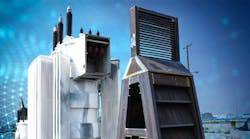About 10 years ago, a sniper attack on an electric power substation in Northern California caused more than $15 million in damages as it destroyed 17 transformers. Since then, researchers at the Idaho National Laboratory have been trying to devise a way to protect vulnerable transformers and other electric gear. They came up with an Armored Transformer Barrier and licensed it for production to Michigan-based Waltonen Engineering.
It is made from inexpensive-yet-rugged military grade steel and creates a formidable barricade to protect high-valued, critical substations from threats ranging from high-powered rifles to vehicles laden with explosives. It also remains stable in Category 2 hurricanes without the need for expensive footings or anchors.
Each barrier system consists of an A-shaped frame, two armor cassettes that slide into the frame and an optional top-hat armor extension. A separate corner piece locks in to provide seamless 360-deg. protection. Each barrier can be transported unassembled on a commercial truck to a substation site and assembled with simple hand tools, forklifts and cranes.
Although grid damaging events are rare in the U.S., organizations including the Department of Homeland Security, Congressional Research Service and the National Academies of Science have warned of the effects from a long-term power outage caused attacks on key parts of the grid. In 2015, Congress passed legislation to develop a strategic reserve of transmission equipment.
Currently, the U.S. imports about 85% of its high-voltage transformers. These large, custom-built devices cost $2.5 million to $10 million each. With limited supplies, expensive raw materials and fabrication times of more than a year, the loss of a single piece of equipment could prevent reliable power from being delivered, creating a risk to national security, economic stability and public health.
